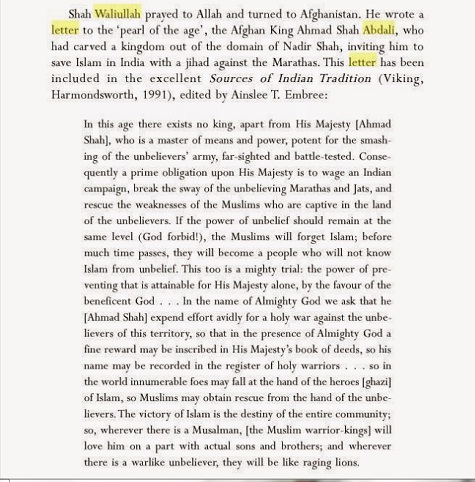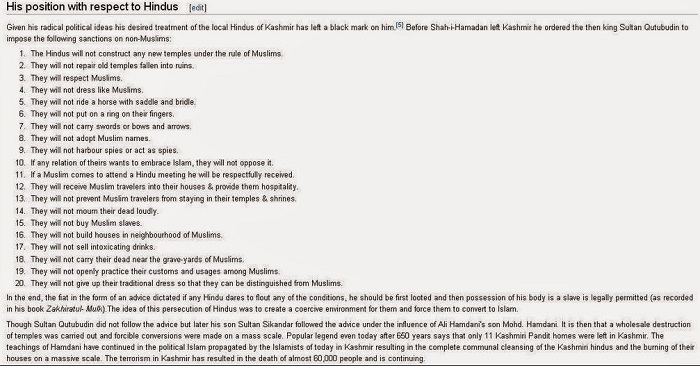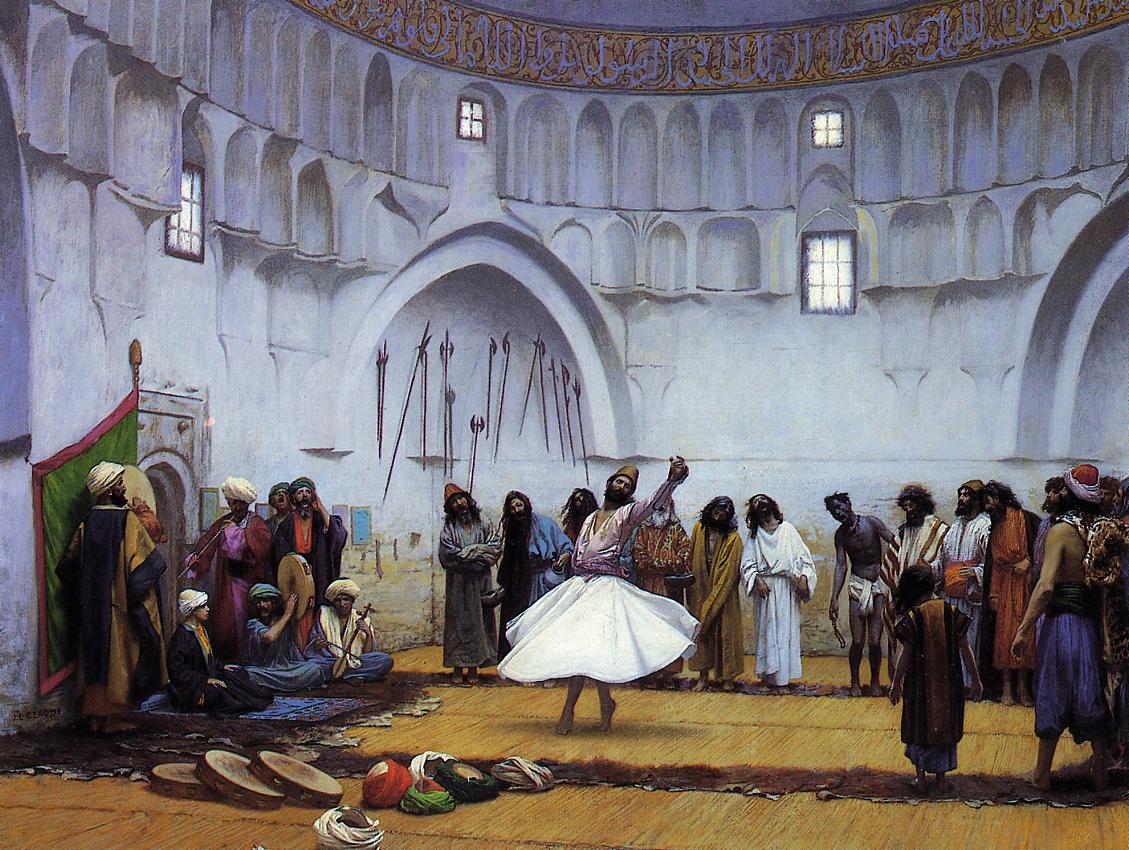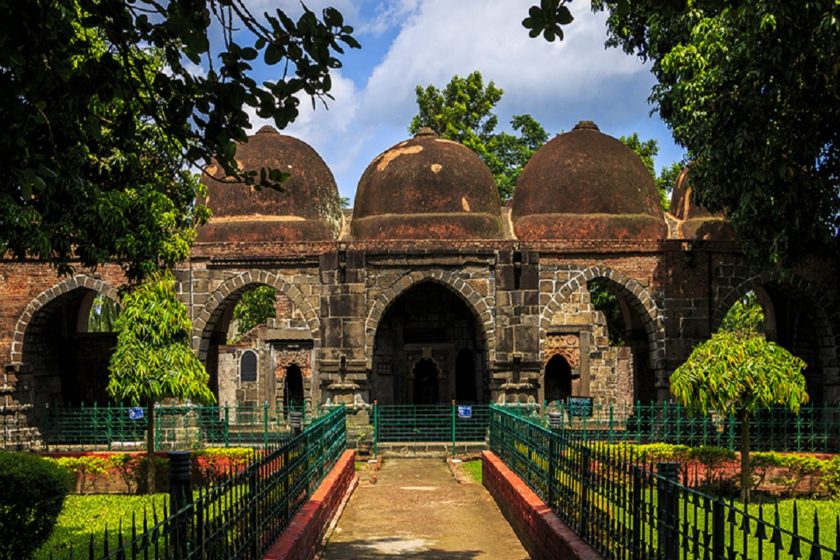Sufism and Indian History – A Factual Critique
Yeah Sufi is indeed the dervish who dances
Hidden hatred in his gyration and mystical trances,
He’s not always armed with merely a flute
He secretly loves swords and guns to shoot,
Sufi likes to paint the world dark gory red
Those who don’t convert better drop dead,
Feeble Hindus have been a target so damn easy
To propagate Islamic Jihad all sordid and sleazy,
Under garb of spirituality and awakening the soul
Power and proselytization was the actual goal,
Though we’ve relished Rumi’s poems for years
Never could see Kafirs’ rape blood and tears,
The Chistis and Auliyas have had a darker side
Death and curse for the infidel who did not abide.
Sufism is the mystical school of Islam which is defined as ‘a science whose objective is the reparation of the heart and turning it away from all else but God’. The lexical roots of ‘Sufi’ are usually traced to –
suf = wool
safa’ = purity
Etymologically it may mean somebody wearing a woolen cap or having a pure heart. While the former seems more likely looking at our history, the latter is preferred by Islamic scholars today (for obvious reasons). The Sufi branch of Islam has enjoyed spectacularly good press in the west. Hailed as peaceful mystics who believe jihad is an internal spiritual quest, nothing violent or unpleasant. Sufism has attracted favorable attention and converts from all sorts of infidels around the world.
Sufis are actually devout Muslims praying 5 times a day and following all basic tenets of orthodox Islam. In most Sufi schools, including the Shadhiliyya order of North Africa; the Naqshbandi of Central Asia, the Persian Nimatullahis, Indian Chishtis, Turkish Helvetis, and Qadiris from several dozen countries, a prerequisite to partaking of the teachings is confession of the Islamic statement of faith, the shahadah. How can a religious school which claims only my god is the real god and rest are all false gods be eclectic or syncretic?

Muhammad ar-Rasul’Allah
There is no god but Allah;
Muhammad is the Prophet of God
“Sufism is the bastard child born out of the intellectual rape of the Iranian literati by Islam.”
“The Sufis could not reform Islam or make it more humane. All they did is to conceal its ugliness and thus make it even more dangerous trap for the unwitting victims“ – Dr. Ali Sina
While most Indians perceive Sufism as a mystical, syncretic and re-conciliatory halfway house between Islam and Hinduism, the truth is a lot murkier. Though most take Sufis as the ‘good Islam’ (the Islam that prince Charles and David Cameroon adore ), that it is all about peace, tolerance and intoxicated mystical trances, some of the most dangerous violent masterminds have been either Sufis, or aided and eulogized by Sufis.
A close examination of the history of Islamic proselytization activities (Islamization) in India proves that Sufism, through its missionary activities complemented the conversion of Hindus to Islam. Sufism, on one hand supported the Muslim invaders and Sultans in their political activities and reckless killings of the Hindus, and on the other hand, influenced the gullible Hindus through their drama of spiritualism and mysticism.
The greatest Sufi ideologue Ghazali exhorted:
“One must go on jihad at least once a year…one may use a catapult against them [non—Muslims] when they are in a fortress, even if among them are women and children. One may set fire to them and/or drown them…If a person of the Ahl al—Kitab [People of The Book — primarily Jews and Christians] is enslaved, his marriage is [automatically] revoked…One may cut down their trees…One must destroy their useless books. Jihadists may take as booty whatever they decide…they may steal as much food as they need.“
About payment of Jizya by the infidels he wrote:
“The dhimmi is obliged not to mention Allah or His Apostle…Jews, Christians, and Majians must pay the jizya, on offering up the jizya, the dhimmi must hang his head while the official takes hold of his beard and hits [the dhimmi] on the protruberant bone beneath his ear [i.e. the mandible]. They are not permitted to ostentatiously display their wine or church bells…their houses may not be higher than the Muslim’s, no matter how low that is. The dhimmi may not ride an elegant horse or mule; he may ride a donkey only if the saddle is of wood. He may not walk on the good part of the road. They [the dhimmis] have to wear [an identifying] patch [on their clothing], even women, and even in the [public] baths…[dhimmis] must hold their tongue….”
Indian Sufis:
When the Turks establishedIslamic rule in India (1206), Sufism gained wide acceptance in Islamic societies. Following the trail of Muslim invaders, Sufis and Sufism poured into India. With them came the new missionary zeal to convert the infidels from darkness to light of Islam.The option of course for those Kafirs who did not convert, was always to die. Many other famous Sufis also revered bloodthirsty Aurangzeb, including the Punjab Sufi Sultan Bahu who wrote ‘Aurang-i-Shahi’ praising the emperor as a just ruler. Now Aurangzeb or Alamgir is notorious in history as the Mughal who tried to annihilate Hinduism completely, destroying temples and suppressing religious practices. Guru Tegh Bahadur and his two close companions Bhai Matti Das and Bhai Fateh Das were executed for refusing to convert to Islam. Aurangzeb’s tomb is in Khuldabad in Maharashtra within the courtyard of the shrine of the Sufi saint Shaikh Burham-u’d-din Gharib.
This association of the most fanatic and intolerant of Mughal emperors with Sufism will shock many who have been fed the belief that all Sufis were purveyors of a soft version of Islam. But the Naqshabandis had always stood for strict interpretation of sharia law. Khwaja Mohammad Baqi Billah Berang, whose tomb is in Delhi, introduced Naqshbandi order in India and due to common Turkic origins with the Mughal invaders, this Sufi order always remained steadfast in its political loyalty right from the invasions of Babar.
Moinuddin Chisti : He’s one of the most popular Sufi saints in India. Born in Sijistan in eastern Persia in C.E. 1141, he came to India with the army of invading marauder Ghori in 1192 and selected Ajmer as his permanent abode since 1195. It is said that once when he went to perform the pilgrimage to the holy tomb of the Prophet Mohammed, one day from the inside of the pure and blessed tomb a cry came: ‘Send for Moinuddin’. When Moinuddin came to the door, he stood there and he saw that presence speak to him.“Mouinuddin, you are the essence of my faith, but must go to Hindustan. There is a place called Ajmer, to which one of my sons (descendants) went for a holy war, and now he has become a martyr, and the place has passed again into the hands of infidels. By the grace of your footsteps there, once more shall Islam be made manifest, and the Kafirs be punished by God’s wrath“.
The Khwaja had a burning desire to destroy the rule of the brave Rajput king, Prithiviraj Chauhan, so much so that he ascribed the victory of Mohammed Ghori in the battle of Tarain entirely to his own spiritual prowess and declared that “We have seized Pithaura (Prithviraj) alive and handed him over to the army of Islam “
Sculpted stones, apparently from a Hindu temple, are incorporated in the Buland Darwãza of Moin-ud-din’s shrine at Ajmer and his tomb is built over a series of cellars which may have formed part of an earlier temple. A tradition, first recorded in the ‘Anis al-Arwãh, suggests that the Sandal Khana is built on the site of Hindu temple. Four Islamic mystics namely Moinuddin (in Ajmer ), Qutubuddin (in Delhi ), Nizamuddin ( in Delhi ) and Fariduddin (in Pattan now in Pakistan ) accompanied the Islamic invaders in India . All of them were from the Chistiya order of Islamic Sufi mysticism.
Nizamuddin Auliya: (1238-1325) -Toeing the orthodox line, he condemned the Hindus to the fire of hell, saying: “The unbelievers at the time of death will experience punishment. At that moment, they will profess belief (Islam) but it will not be reckoned to them as belief because it will not be faith in the Unseen… the faith of (an) unbeliever at death remains unacceptable.” He asserted that “On the day of Resurrection when unbelievers will face punishment and affliction, they will embrace faith but faith will not benefit them, They will also go to Hell, despite the fact that they will go there as believers“. In his khutbas (sermons), Nizamuddin Auliya condemned the infidels as wicked, saying, “He (Allah) has created Paradise and Hell for believers and the infidels in order to repay the wicked for what they have done”.
Auliya’s thought on Jihad against non-Muslims can be gleaned from his statement that Surah Fatihah, first chapter of the Quran, did not contain two of the ten cardinal articles of Islam, which were ‘‘warring with the unbelievers and observing the divine statutes…’’ He did not only believe in warring with the unbelievers or jihad, he came to India with his followers to engage in it. He participated in a holy war commanded by Nasiruddin Qibacha in Multan. When Qibacha’s army was in distress facing defeat, Auliya rushed to him and gave him a magical arrow instructing: ‘‘Shoot this arrow at the direction of the infidel army.’ …Qibacha did as he was told, and when daybreak came not one of the infidels was to be seen; they all had fled!’ When Qazi Mughisuddin inquired about the prospect of victory in the Jihad launched in South India under the command of Malik Kafur, the Auliya uttered in effusive confidence: ‘What is this victory? I am waiting for further victories.’ The Auliya used to accept large gifts sent by Sultan Alauddin from the spoils plundered in jihad expeditions and proudly displayed those at his khanqah (lodge). Auliya had also sent forth Shaykh Shah Jalal, the greatest Sufi saint of Bengal, with 360 disciples to take part in a holy war against King Gaur Govinda of Sylhet.
Amir Khusrau: He showed delights in describing the barbaric slaughter of Hindu captives by Muslim warriors. Describing Khizr Khan’s order to massacre 30,000 Hindus in the conquest of Chittor (Padmini Jauhar) in 1303, he gloated: ‘Praise be to God! That he so ordered the massacre of all chiefs of Hind out of the pale of Islam, by his infidel smiting swords… in the name of this Khalifa of God, that heterodoxy has no rights (in India).’ He took poetic delight in describing Malik Kafur’s destruction of a famous Hindu temple in South India and the grisly slaughter of the Hindus and their priests therein. In describing the slaughter, he wrote, “The heads of Brahmans and idolaters danced from their necks and fell to the ground at their feet, and blood flowed in torrents.” In his bigoted delight at the miserable subjugation of Hindus and the barbarous triumph of Islam in India, he wrote: “The whole country, by means of the sword of our holy warriors, has become like a forest denuded of its thorns by fire? Islam is triumphant, idolatry is subdued. Had not the Law granted exemption from death by the payment of poll-tax, the very name of Hind, root and branch, would have been extinguished. “
Amir Khasrau described many instances of barbaric cruelty, often of catastrophic proportions, inflicted by Muslim conquerors upon the Hindus. But nowhere did he show any sign of grief or remorse, but only gloating delight. While describing those acts of barbarism, he invariably expressed gratitude to Allah, and glory to Muhammad, for enabling the Muslim warriors achieve those glorious feats.
Shaikh Ahmad Sirhindi: The mission of Shaikh Sirhindi popularly known as Mujadid was to purify Islam from the influence of Akbar with a view to countering his policy of “Peace with all”. Unhappy with the regime of Emperor Akbar for withdrawal of Jizya tax imposed on the Hindus, Sirhindi made frantic effort to purge Islam of all extraneous influences. He viewed Hindu mystics like Guru Nanak and Sant Kabir despicable, as they did not follow Sharia. Sirhindi condemned the reign of Akbar for his ‘broadmindedness’ and policy of ‘peace with all’.
He strongly criticized freedom of worship granted to the Hindus. Hate-Hindu syndrome was so deep in him that death of Akbar (1605) filled Shaikh Ahmad with hopes that the pristine purity of Islam would be implanted in India. With his strong contempt against Shias and the Hindus, Sirhind wrote several letters to the nobles in the court of Jahangir for guiding the emperor on the path of Shariat, and for removal of Kafirs (Shias and Hindus) from the administration. He was dead against any honourable status of Hindus in Islamic government. Sirhind wanted the religious freedom enjoyed by the Hindus during Akbar regime to be curbed. Enraged with his too much interference in administration, Jahangir imprisoned him in Gwalior but released him after one year. Despite this anti-Hindu tirade of Sirhindi, Maulana Abul Kalam Azad in 1919 eulogized the role of Mujaddid (Sirhind). He once wrote: “The honor of Islam lies in insulting kufr and kafirs. One who respects the kafirs dishonors the Muslims. The real purpose of levying jiziya on them is to humiliate them to such an extent that they may not be able to dress well and to live in grandeur. They should constantly remain terrified and trembling. It is intended to hold them under contempt and to uphold the honor and might of Islam.“
Shah Waliullah: This traitor who invited Ahmed Shah Abdali to invade India was a Sufi belonging to Naqshbandi order. Waliullah believed that he was sent by God to save and lead the Muslims of India. To revive Muslim power in India, Waliullah decided to deliver a death blow to the Marathas, Sikhs, and the Jats. He wrote letters to Najib-ud-Daulah and Ahmad Shah Abdali, advising that Muslim property should not be looted by the army. In one letter, he warned Ahmad Shah Abdali to watch out for some Hindus in his service who appeared loyal to him but were actually insincere to Abdali’s cause. In his letters, he advised that Muslim soldiers could not fight against Muslim rulers as God would check their movement and prevent any action which could be harmful to Islam.
According to Shah Waliullah, the subcontinent was not the real homeland for the Muslims and that they were mere strangers. He introduced the idea among the Muslims of India that they should embrace Arab culture and language and that God would help them to get out of the subcontinent. Had it not been for this Islamic extremist born in india who invited non -Indians to attack India, the third battle of Panipat ( 14 Jan 1761) might not have taken place. Sad and ironical that this Jihadi fundamentalist ‘inspired’ orthodox Sunni Deobandi school of Islam in India which has a high percentage of followers among Indian Muslims.

Sufis in Kashmir:
Bulbul Shah and Shah Mir: Both Sufis treacherously sowed the seeds of Islam in Kashmir (the land of Rishi Kashyap) by fraudulently converting Prince Rinchain to Islam.There was competition and conflict between Buddhism and Hinduism in the court of King Rinchain. Shah Mir convinced Rinchain that he could choose to convert to Hinduism, Buddhism or Islam. Shah Mir suggested to Rinchain that he could convert to the religion of the first person they encounter next morning. The next morning when they left the palace, the first person they met was Muslim Sufi Sayed Sharafuddin Bulbul Shah who was performing his morning prayers. Rinchain converted to Islam and adopted the Muslim name of Sultan Sadruddin. Shah Mir pre-planned the morning meeting with Bulbul Shah to convert King Rinchan to Islam.
Syed Hamdani: The first thing he did was to build his khanqah [lodge or ashram] on the site of a small temple which was demolished. Hamdani was horrified by the un-Islamic practices of Kashmiri Muslims, and forbade this laxity and tried to revive orthodoxy. The reigning Sultan Qutbud-Din tried to adopt Islamic orthodoxy in his personal life, but “failed to propagate Islam in accordance with the wishes and aspirations of Amir Sayyid Ali Hamdani” . As a result, the Sufi saint left Kashmir because of his reluctance to live in a land dominated by the idolatrous culture, customs and creed. This is what Syed Hamdani sanctioned for Kashmiri Hindus:-

Amir Sayyid Muhammad Hamdani: The Sufi who came to Kashmir during the reign of Sikander and changed him to ‘Sikandar Butshikan’ (“Sikandar the Iconoclast”).Sikandar won the sobriquet of butshikan or idol-breaker, due to his actions related to the desecration and destruction of numerous temples, caityas, viharas, shrines, hermitages and other holy places of the Hindus and Buddhists. He banned dance, drama, music and iconography as aesthetic activities of the Hindus and Buddhists and declared them as heretical and un-Islamic. He forbade the Hindus to apply a tilak mark on their foreheads. He did not permit them to pray and worship, blow a conch shell or toll a bell. Eventually he went on burning temples and all Kashmiri texts to eliminate Shirk. Sikandar stopped Hindus and Buddhists from cremating their dead. Jizya (poll-tax) equal to 4 tolas of silver was imposed on the Hindus. Writes A.K. Mujumdar,“These Sufi Muslim immigrants brought with them that fanatic iconoclastic zeal which distinguished Islam in other parts of India, but from which Kashmir was happily free up to this time.” He further records, “Sikandar’s reign was disgraced by a series of acts, inspired by religious bigotry and iconoclastic zeal for which there is hardly any parallel in the annals of the Muslim rulers of Kashmir.”
Sufi terror in Bengal:
An investigation of two greatest Sufi saints of Bengal outlined below will give us an inkling of the roles Sufis played in the proselytization and how peaceful it was. Two Jalaluddins, Shaykh Jalaluddin Tabrizi (d. 1226 or 1244) and Shaykh Shah Jalal (d. 1347), were the greatest Sufi saints of Bengal. Shaykh Jalaluddin Tabrizi came to Bengal after Bakhtiyar Khilji conquered Bengal defeating the Hindu King Lakshman Sena in 1205. He settled in Devtala near Pandua (Maldah, West Bengal). He is said to have “converted large number of Kafirs” to Islam but the method of his conversions is unknown. According to Syed Athar Abbas Rizvi, ‘a kafir (Hindu or Buddhist) had erected a large temple and a well (at Devtala). The Shaikh demolished the temple and constructed a takiya (khanqah)…’ This will give one a good deal of idea about the kind of means this great Sufi saint had employed in converting the kafirs to Islam.
Shaykh Shah Jalal, the other great Sufi saint of Bengal, had settled in Sylhet. He is regarded as a national hero by Bangladeshi Muslims. Shah Jalal and his disciples are credited with converting a large majority of Bengalis to Islam through truly peaceful means.
When Shah Jalal came to settle in Sylhet in East Bengal (now Bangladesh), it was ruled by a Hindu king, named Gaur Govinda. Before his arrival in Bengal, Sultan Shamsuddin Firuz Shah of Gaur had twice attacked Gaur Govinda; these campaigns were led by his nephew, Sikandar Khan Ghazi. On both occasions, the Muslim invaders were defeated. The third assault against Gaur Govinda was commanded by the sultan’s Chief General Nasiruddin. Shaykh Nizamuddin Auliya sent forth his illustrious disciple Shah Jalal with 360 followers to participate in this Jihad campaign. Shah Jalal reached Bengal with his followers and joined the Muslim army. In the fierce battle that ensued, King Gaur Govinda was defeated. According to traditional stories, the credit for the Muslim victory goes to Shah Jalal and his disciples.
As a general rule, every victory in Muslim campaigns brought a great many slaves, often tens to hundreds of thousand, who involuntarily became Muslim. Undoubtedly, on the very first day of Shah Jalal’s arrival in Sylhet, he helped conversion of a large number of kafirs by means of their enslavement at the point of the sword—a very peaceful means of propagating Islam indeed! Ibn Battutah, who paid a visit to Shah Jalal in Sylhet, records that his effort was instrumental in converting the infidels who embraced Islam there. But he gives no detail of the measures the Sufi saint employed in the conversion. One must take into consideration that Shah Jalal ‘came to India with 700 companions to take part in Jihad (holy war)’ and that he fought a bloody Jihad against King Gaur Govinda. These instances give a clear idea of the tools he had applied in converting the Hindus of Sylhet.
In another instance, Sufi saint Nur Qutb-i-Alam played a central role in making a high profile convert in Bengal. In 1414, Ganesha, a Hindu prince, revolted against Muslim rule and captured power in Bengal. The ascension of a Hindu to power created strong revulsion amongst both the Sufis and the Ulema. They repudiated his rule and enlisted help from Muslim rulers outside of Bengal. Responding to their call, Ibrahim Shah Sharqi invaded Bengal and defeated Ganesha. Nur Qutb-i-Alam, the leading Sufi master of Bengal, now stepped in to broker a truce. He forced Ganesha to abdicate and Ganesha’s twelve-year-old son Jadu was converted to Islam and placed on the throne under the name of Sultan Jalaluddin Muhammad. This conversion by a Sufi saint, call it peacefully or at the point of the sword, proved a boon for Islam. The Sufis (also the Ulema) trained the converted young sultan in Islam so well that he became a bloody converter of the infidels to Islam through extreme violence. There took place, says the Cambridge History of India, a wave of conversions in the reign of Jalaluddin Muhammad (1414–31).
About Jalaluddin’s distinguished role in converting the Hindus of Bengal to Islam, Dr James Wise wrote in the Journal of the Asiatic Society of Bengal (1894) that ‘the only condition he offered was the Koran or death… many Hindus fled to Kamrup and the jungles of Assam, but it is nevertheless possible that more Mohammedans were added to Islam during these seventeen years (1414–31) than in the next three hundred years.’
Sufis and Gullible Hindus
The Sufis in India found great acceptability among gullible Hindus and they were respected for their deportment, dress, and use of Hindu terminology and for the manner in which they generally conducted themselves. They even adapted and adopted Hindu methods to make their cult attractive. It was propagated that the Atharva Veda was faithfully practiced by them. Their ‘Rishi Movement’ was an integral component of the process of Islamisation that started in the Kashmir valley in the wake of the introduction of the Sufi orders from Central Asia and Iran in the fourteenth century. In general they used their spiritual clout for converting Hindus without immediately changing their culture, i.e. externally they would be Hindus, but internally they were Muslims (crypto-Muslims) following all Hindu practices . The following terms common to Sufis all over the world and most probably borrowed by Sufis originally from Hindus, were used stressing their similarity to Hindu concepts.
‘Fikr’ – Dhyan
‘Zikr’ – Smarana or Japa
‘Voral Zikr ‘ – Bhajan
‘Wird ‘ – Manana
‘Shuhud’ – Final stage of dhyana
‘Tasbih’ – Mala or rosary
The following Sufi terms were used for their equivalents for the various Hindu stages of spiritual progress –
‘Talab’ – Yearning for God
‘Ishq’ – Love for this attainment
‘Marfat ‘ – Enlightenment after realisation
‘Fana’ – Surrender
‘Tauhid ‘ – Experiencing Allah permeating all
‘Hairat ‘ – Ecstasy attained at the sight of Divinity
‘Fukr Wa Fana’ – Moksha or Nirvana
Conclusion: Sufism in India has commonly been viewed as a secular attempt for eternal quest of the soul for its direct experience of the ultimate Super power. For centuries imbecile Hindus accepted Sufi shrines as a a symbol of communal harmony. A large number of them have been offering prayers in Sufi shrines without any reservation, but this liberal gesture has not been reciprocated ever by Muslims.Had Sufism been as commonly been viewed as an attempt to adapt Islam in Hindu tradition, there would have been no Islamic Jihad and separatism in India.. Contrary to the common perception that Sufism tried to unify the Hindu-Muslim spirituality for a communal harmony, the political Islamists of Sufi background accelerated the process of Muslim separatism in Indian subcontinent. Their movements were the by-products of Sufi tradition of Islam, and were basically in favour of the political power of Islam in India. The ideology propounded by Waliullah finally ended up vivisecting the country in 1947.
Hindus in this country have been misled into believing that these Sufis were spirituality seekers analogous to Hindu sages and seers. These savages have been presented as saints by dhimmi Indian politicians, ignorant Bollywood actors, careless cricketers and so called secular media. Self-loathing feeble minded dhimmi Hindus have always been like turkeys voting for an early Christmas.
References:
http://wikiislam.net/wiki/Sufi
http://www.superluminal.com/cookbook/essay_many_flavors.html
http://www.livingislam.org/k/si_e.html
‘Islamic Jihad: A Legacy of Forced Conversion, Imperialism, and Slavery’- MA Khan
‘Sufis and Sufism in india X-rayed’- Rajesh Ghambhava
http://www.americanthinker.com/articles/2005/05/sufi_jihad.html
‘The shrine and cult of Muinuddin Chishti of Ajmer’ -PM Curie
http://en.wikipedia.org/wiki/Rinchan
http://en.wikipedia.org/wiki/Sikandar_Butshikan
‘A History Sufism in India’ -Saiyed Athar Abbas Rizvi
‘The Story of Islamic Imperialism in India’- Sitaram Goel
http://en.wikipedia.org/wiki/Deobandi
http://www.chakranews.com/beauty-and-the-beast-of-sufism
‘Islam In india’- Ashok Joshi
Note: The whirling dervesh concept is not common in India.


